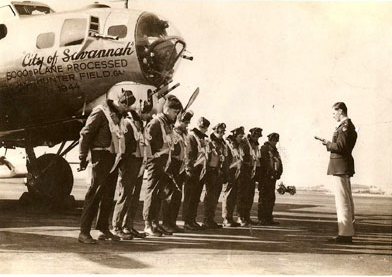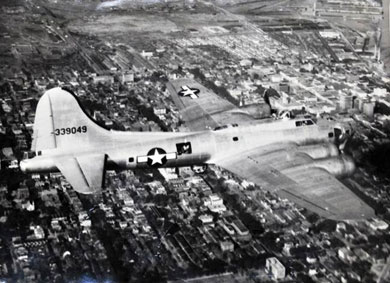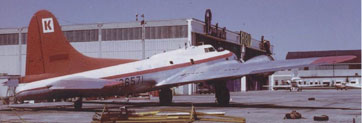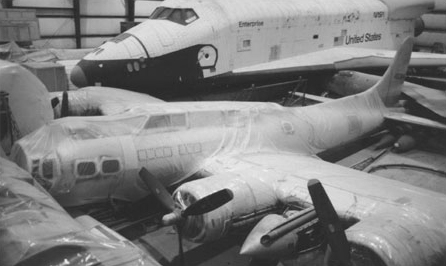A Tail of Two "Cities"
 The
Mighty Eighth Air Force Museum welcomed the B-17, serial number
44-83814, to Savannah on Jan. 15, 2009. Today, the airplane
occupies a place of honor in the museum’s Combat Gallery. It
also has a new name—the City of Savannah. The story
of how the airplane arrived at its permanent home in the gallery,
and how it got its name is really two stories.
The
Mighty Eighth Air Force Museum welcomed the B-17, serial number
44-83814, to Savannah on Jan. 15, 2009. Today, the airplane
occupies a place of honor in the museum’s Combat Gallery. It
also has a new name—the City of Savannah. The story
of how the airplane arrived at its permanent home in the gallery,
and how it got its name is really two stories.
The Original City of Savannah
The first story starts in late
1944, at the height of World War II, when the residents of Chatham
County, Georgia, the home of the Mighty Eighth Air Force Museum,
raised $500,000 to pay for the production of one B-17 bomber
and the training of the 10 men who would make up its crew. In
late November 1944, new B-17s and recently graduated air crews
were brought together at Hunter Field in Savannah, Ga., and
then sent to overseas units. Shortly after Thanksgiving, the
U.S. Army Air Corps matched the crew piloted by Lt. Ralph Kittle
with a B-17 bomber, serial number 43-39049, which happened to
be the 5,000th airplane to be processed through Hunter Field
destined to support Allied forces in Europe. The airplane was
painted with the name City of Savannah to honor the
Chatham County fundraisers. Lt. Kittle and his crew were photographed
with the airplane. The citizens of Chatham County were honored
for their generosity and support at a ceremony, and a special
blessing was bestowed on the crew for its safety. And then the
crew and the airplane departed for England.

Not long after they arrived in England, Lt. Kittle and his crew
were separated from the City of Savannah. They were assigned
to the 388th Bomb Group, and were shot down by anti-aircraft
fire on March 5, 1945 while on their 13th mission – to the city
of Plauen, in Germany. They were flying an older “F” model B-17
with the Tail Number 42-97642. One crew member, tail gunner
Robert H. Warren was killed. The remaining crewmen became prisoners
of war until they were repatriated in May of 1945. The B-17
bomber they flew to England, S/N 43-39049, the original City
of Savannah returned to the United States in July 1945
and was eventually scrapped.
Today’s City of Savannah
Story number two begins 64
years later. Historians conducting research on the present B-17
City of Savannah discovered that S/N 44-83814 was produced
in May 1945 at an aircraft-assembly plant in Long Beach, Calif.
Unfortunately, it was built too late to take part in the war.
By the time it rolled out of the hangar, the war in Europe was
drawing to a close, so the Army Air Force simply dropped the
airplane from its rolls.
 S/N
44-83814 managed to avoid the scrap yards after the war. It
passed through a series of civilian owners who used it to perform
a variety of tasks. It spent 20 years taking photographs around
the world for a mapmaking company in Canada. Part of its duties
involved charting the Distant Early Warning Line. The DEW Line
was a series of radar stations situated primarily in the far
northern reaches of the Canadian Arctic. They were established
to provide advanced notice of an airborne or land-based invasion
by Soviet aircraft or troops during the Cold War. Later, from
1974 to 1984, the airplane served as a slurry bomber fighting
forest fires. It operated out of a base in Arizona.
S/N
44-83814 managed to avoid the scrap yards after the war. It
passed through a series of civilian owners who used it to perform
a variety of tasks. It spent 20 years taking photographs around
the world for a mapmaking company in Canada. Part of its duties
involved charting the Distant Early Warning Line. The DEW Line
was a series of radar stations situated primarily in the far
northern reaches of the Canadian Arctic. They were established
to provide advanced notice of an airborne or land-based invasion
by Soviet aircraft or troops during the Cold War. Later, from
1974 to 1984, the airplane served as a slurry bomber fighting
forest fires. It operated out of a base in Arizona.
 In 1984, the airplane was traded to the Smithsonian Institution
and placed in long-term storage. It remained in storage until
the Smithsonian presented it to the Mighty Eighth Air Force
Museum in 2009.
In 1984, the airplane was traded to the Smithsonian Institution
and placed in long-term storage. It remained in storage until
the Smithsonian presented it to the Mighty Eighth Air Force
Museum in 2009.